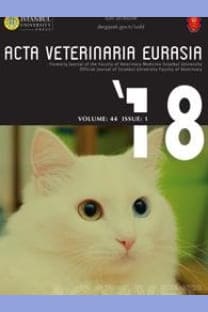Kafes Kuşlarının Gaitalarında Candida Türlerinin Araştırılması
Candida, gaita, kafes kuşları, kandidiyaz, psittasin
-
Cage birds, Candida, candidiasis, psittacine, stool sample,
___
- Anaissie, E . J . , McGinnis, M.R., Pfaller, M.A., 2009. Clinical Mycology 2 n d Edition. Elsevier Health Sciences, Philadelphia, pp. 197-231.
- Arıkan, S., Tunçkanat, F., Günalp, S., Ergüven, S., Günalp, A., 1997. Vajinal akıntı yakınmasıyla başvuran hastalarda etkenlerin mikrobiyolojik olarak değerlendirilmesi. Mikrobiyoloji Bülteni 31 (2), 103-111.
- Bauck, L . , 1994. Mycoses. In: Ritchie, B.W., Harrison, G.J., Harrison, L.R. (Eds.), Avian Medicine: Principles and Application, Veterinary Medicine; Avian, Chapter 35. Wingers Publishing, Florida, pp. 998-1005.
- Brilhante, R., Maia, D., Soares, G., Monteiro, A., Medrano, D., Cordeiro, R., Sidrim, J . , Rocha, M., 2010. Characterization of the gastrointestinal yeast microbiota of cockatiels (Nymphicus hollandicus): A potential hazard to human health. Journal of Medical Microbiology 59 (6), 718-723.
- Butcher, G.D., Miles, R.D., 1991. Improved aviculture management may prevent candidiasis in birds. University of Florida, Veterinary Medicine Series No:73. http://edis.ifas.ufl.edu/pdffiles/ VMZVM03100.pdf (Erişim: 14.04.2011).
- Cabanes, F . J . , 2010. Yeast pathogens of domestic animals. In: Ashbee, H.R., Bignell, E.M. (Eds.), Pathogenic Yeasts, The Yeast Handbook Series. Springer, Berlin, pp. 253-255. de Hoog, G.S., Guarro, J . , Gene, J . , Figueras, M.J., 2000. Atlas of Clinical Fungi 2 n d Edition.
- Centraalbureau voor Schimmelcultures, The Netherlands, pp. 176-227. Erbakan, N., 1989. Derinin Mantar Hastalıkları, Birinci Baskı. Türkiye Klinikleri Yayınevi, Ankara, pp. 173-212.
- Erdeğer, J . , 2002. Kandidiyaz. İçinde: İzgür, M . , Akan, M . (Ed.), Kanatlı Hayvan Hastalıkları.
- Medisan Yayınevi, Ankara, pp. 232-233. Hazen, K . C . , Howell, S.A., 2009. Candida, Cryptococcus ve tıbbi önemi olan diğer mayalar. İçinde: Murray, P.R., Baron, E.J., Jorgensen, J.H., Pfaller, M.A., Landry, M.L.
- (Eds.), Manual of Clinical Microbiology 9 t h Edition. ASM Press, Washington DC, pp. 1721-1781.
- Hochleithner, M., 2003. Common diseases and syndromes in pet bird medicine with treatment. In: 28 t h
- World Congress of the World Small Animal Veterinary Association, Bangkok, Thailand. Kano, R., Sakamoto, Y . , Hanahachi, A., Kamata, H., Fukuda, Y . , Fujiwara, K., Hasegawa, A., 200 Molecular identification of Candida parapsilosis from crop mucosa in a cockatiel. Journal of Veterinary Diagnostic Investigation 13 (5), 437-439. Larone, D.H., 2002. Medically Important Fungi: A
- Guide to Identification 4 t h Edition. ASM Press, Washington DC, pp. 109-145. Mancianti, F . , Nardoni, S., Ceccherelli, R., 2002.
- Occurrence of yeasts in psittacines droppings from captive birds in Italy. Mycopathologia 153 (3), 121-124. Marshall, R., 2009. Trush (Candida) Infections. http://www.birdhealth.com.au/bird/er/infections .html (Erişim: 24.06.2011).
- Tantaş, A., Ak, S., Özgür, Y . , 1990. Papağanlarda candidiasiste etiyolojik ve terapotik bulgular ve kriterler üzerine çalışmalar. İstanbul Üniversitesi Veteriner Fakültesi Dergisi 16 (2), 181-1
- The Merck Veterinary Manual, 2011. Exotic and Laboratory Animals, Caged Birds, Mycotic
- Diseases, Candidiasis. http://www.merckvet 120 manual.com/mvm/index.jsp?cfile=htm/bc/1702 htm (Erişim: 15.06.2010).
- Tümbay, E . , 1999. Candida türleri. İçinde: Ustaçelebi, Ş. (Ed.), Temel ve Klinik Mikrobiyoloji. Güneş Kitabevi, Ankara.
- Velasco, M.C., 2000. Candidiasis and cryptococcosis in birds. Seminars in Avian and Exotic Pet Medicine 9 (2), 75-81.
- Bilge Baydaş, Serkan ikiz, A. Atila Ilgaz Vieira, R.G., Coutinho, S.D.A., 2009. Phenotypical characterization of Candida spp. isolated from crop of parrots (Amazona spp.). Pesquisa
- Veterinaria Brasileira 29 (6), 452-456. Wyatt, R.D., Simmons, D.G., Hamilton, P.B., 1975.
- Induced systemic candidiasis in young broiler chickens. Avian Diseases 19 (3), 533-543. Yeğenoğlu, Y . , 2003. Mikoloji ders notu. İstanbul
- Üniversitesi, İstanbul.
- ISSN: 2618-639X
- Başlangıç: 1975
- Yayıncı: İstanbul Üniversitesi-Cerrahpaşa
Kafes Kuşlarının Gaitalarında Candida Türlerinin Araştırılması
Bilge BAYDAŞ, Serkan İKİZ, Atila ILGAZ
Nikolay GORANOV, Mihail PASKALEV, Dian KANAKOV
Yeme Katılan Esansiyel Kekik Yağının Broylerlerde Plazma Lipid Konsantrasyonları Üzerine Etkisi
Factors Affecting Milk Yield Estimated with Different Methods in Brown Swiss Cattle
Figen ÇAKILLI, Kozet AVANUS, Halil GÜNEŞ
Kobaylarda Ön ve Arka Bacak Uzun Kemiklerinin Homotipik Varyasyonları Üzerinde Araştırmalar
Gülsün PAZVANT, K. KAHVECİOĞLU
Investigation of Helicobacter pullorum Occurence in Chicken in the Marmara Region of Turkey
Beren BAŞARAN KAHRAMAN, Seyyal AK
KEÇİLERDE DEĞİŞİK MEME BAŞI ULTRASONOGRAFİ TEKNİKLERİNİN DEĞERLENDİRİLMESİ
İvan FASULKOV, Stanimir YOTOV, Anatoli ATANASOV, Anton ANTONOV
BİR KÖPEKTE TELANJİEKTATİK OSTEOSARKOMA OLGUSU
Gulbin SENNAZLI, Ozge ERDOGAN, Yalcin DEVECIOGLU, Busra INAL
